Note
Click here to download the full example code
Discovering Subgraphs
This example shows how to match a smaller graph to a subset of a larger graph.
# Author: Runzhong Wang <runzhong.wang@sjtu.edu.cn>
# Qi Liu <purewhite@sjtu.edu.cn>
#
# License: Mulan PSL v2 License
Note
The following solvers are included in this example:
import jittor as jt # jittor backend
import pygmtools as pygm
import matplotlib.pyplot as plt # for plotting
from matplotlib.patches import ConnectionPatch # for plotting matching result
import networkx as nx # for plotting graphs
pygm.BACKEND = 'jittor' # set default backend for pygmtools
_ = jt.set_seed(1) # fix random seed
# jt.flags.use_cuda = 1 # use cuda
#! The following code is used for testing jittor codes.
import numpy as np
def namestr(obj):
return [name for name in globals() if globals()[name] is obj][0]
def load_var(*args):
ret = []
for var in args:
ret.append(jt.Var(np.load(f'../{namestr(var)}.npy')))
return ret
def compare_var(*args):
for var in args:
var_np = np.load(f'../{namestr(var)}.npy')
assert np.allclose(var.numpy(), var_np, rtol=1e-4)
Generate the larger graph
num_nodes2 = 10
A2 = jt.rand(num_nodes2, num_nodes2)
A2 = (A2 + A2.t() > 1.) * (A2 + A2.t()) / 2
A2[jt.arange(A2.shape[0]), jt.arange(A2.shape[0])] = 0
n2 = jt.Var([num_nodes2])
Generate the smaller graph
num_nodes1 = 5
G2 = nx.from_numpy_array(A2.numpy())
pos2 = nx.spring_layout(G2)
pos2_t = jt.Var([pos2[_] for _ in range(num_nodes2)])
selected = [0] # build G1 as a cluster in visualization
unselected = list(range(1, num_nodes2))
while len(selected) < num_nodes1:
dist = jt.sum(jt.sum(jt.abs(pos2_t[selected].unsqueeze(1) - pos2_t[unselected].unsqueeze(0)), dim=-1), dim=0)
select_id = unselected[jt.argmin(dist, dim=-1)[0].item()] # find the closest node from unselected
selected.append(select_id)
unselected.remove(select_id)
selected.sort()
A1 = A2[selected, :][:, selected]
X_gt = jt.init.eye(num_nodes2)[selected, :]
n1 = jt.Var([num_nodes1])
Visualize the graphs
G1 = nx.from_numpy_array(A1.numpy())
pos1 = {_: pos2[selected[_]] for _ in range(num_nodes1)}
color1 = ['#FF5733' for _ in range(num_nodes1)]
color2 = ['#FF5733' if _ in selected else '#1f78b4' for _ in range(num_nodes2)]
plt.figure(figsize=(8, 4))
plt.subplot(1, 2, 1)
plt.title('Subgraph 1')
plt.gca().margins(0.4)
nx.draw_networkx(G1, pos=pos1, node_color=color1)
plt.subplot(1, 2, 2)
plt.title('Graph 2')
nx.draw_networkx(G2, pos=pos2, node_color=color2)
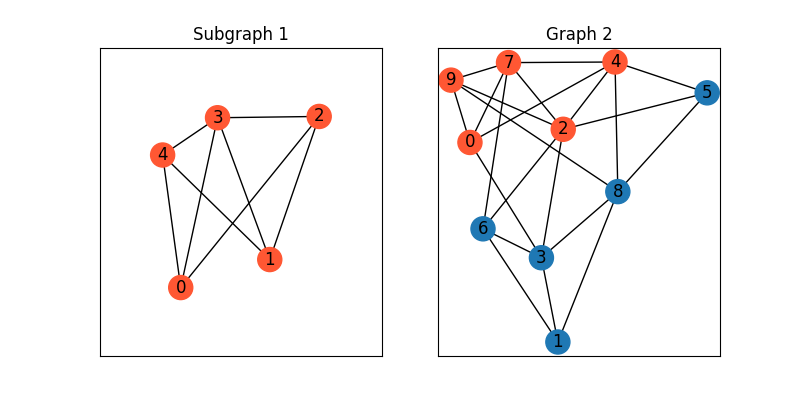
We then show how to automatically discover the matching by graph matching.
Build affinity matrix
To match the larger graph and the smaller graph, we follow the formulation of Quadratic Assignment Problem (QAP):
where the first step is to build the affinity matrix (\(\mathbf{K}\))
conn1, edge1 = pygm.utils.dense_to_sparse(A1)
conn2, edge2 = pygm.utils.dense_to_sparse(A2)
import functools
gaussian_aff = functools.partial(pygm.utils.gaussian_aff_fn, sigma=.001) # set affinity function
K = pygm.utils.build_aff_mat(None, edge1, conn1, None, edge2, conn2, n1, None, n2, None, edge_aff_fn=gaussian_aff)
Visualization of the affinity matrix. For graph matching problem with \(N_1\) and \(N_2\) nodes, the affinity matrix has \(N_1N_2\times N_1N_2\) elements because there are \(N_1^2\) and \(N_2^2\) edges in each graph, respectively.
Note
The diagonal elements of the affinity matrix is empty because there is no node features in this example.
plt.figure(figsize=(4, 4))
plt.title(f'Affinity Matrix (size: {K.shape[0]}$\\times${K.shape[1]})')
plt.imshow(K.numpy(), cmap='Blues')
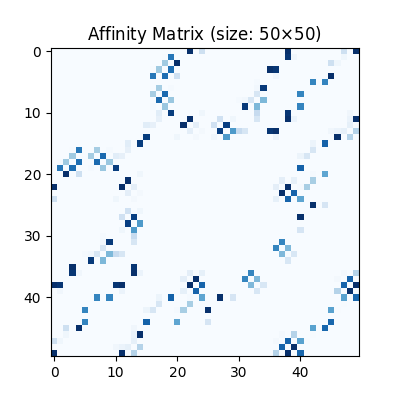
<matplotlib.image.AxesImage object at 0x000001F03D1EAFD0>
Solve graph matching problem by RRWM solver
See rrwm() for the API reference.
X = pygm.rrwm(K, n1, n2)
The output of RRWM is a soft matching matrix. Visualization:
plt.figure(figsize=(8, 4))
plt.subplot(1, 2, 1)
plt.title('RRWM Soft Matching Matrix')
plt.imshow(X.numpy(), cmap='Blues')
plt.subplot(1, 2, 2)
plt.title('Ground Truth Matching Matrix')
plt.imshow(X_gt.numpy(), cmap='Blues')
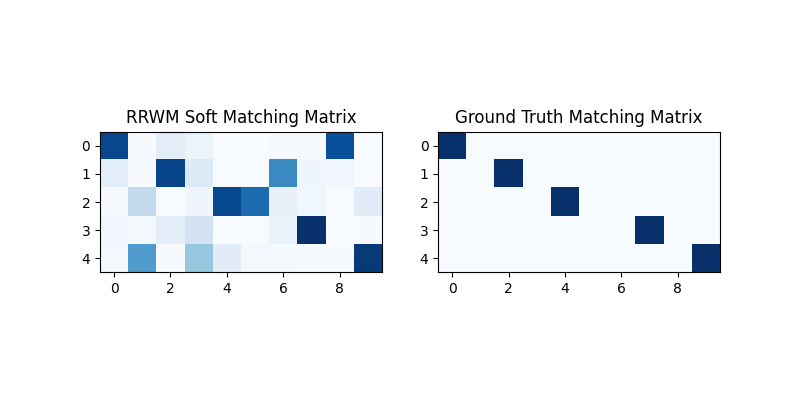
<matplotlib.image.AxesImage object at 0x000001F03DE77D60>
Get the discrete matching matrix
Hungarian algorithm is then adopted to reach a discrete matching matrix
X = pygm.hungarian(X)
Visualization of the discrete matching matrix:
plt.figure(figsize=(8, 4))
plt.subplot(1, 2, 1)
plt.title(f'RRWM Matching Matrix (acc={(X * X_gt).sum()/ X_gt.sum():.2f})')
plt.imshow(X.numpy(), cmap='Blues')
plt.subplot(1, 2, 2)
plt.title('Ground Truth Matching Matrix')
plt.imshow(X_gt.numpy(), cmap='Blues')
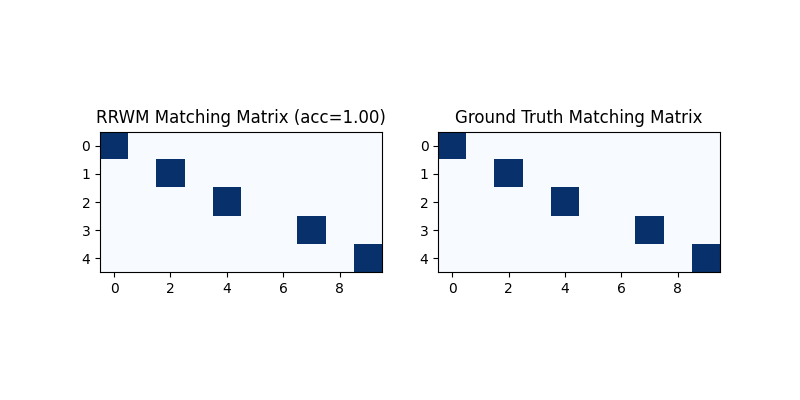
<matplotlib.image.AxesImage object at 0x000001F03E467970>
Match the subgraph
Draw the matching:
plt.figure(figsize=(8, 4))
plt.suptitle(f'RRWM Matching Result (acc={(X * X_gt).sum()/ X_gt.sum():.2f})')
ax1 = plt.subplot(1, 2, 1)
plt.title('Subgraph 1')
plt.gca().margins(0.4)
nx.draw_networkx(G1, pos=pos1, node_color=color1)
ax2 = plt.subplot(1, 2, 2)
plt.title('Graph 2')
nx.draw_networkx(G2, pos=pos2, node_color=color2)
for i in range(num_nodes1):
j = jt.argmax(X[i], dim=-1)[0].item()
con = ConnectionPatch(xyA=pos1[i], xyB=pos2[j], coordsA="data", coordsB="data",
axesA=ax1, axesB=ax2, color="green" if X_gt[i,j] == 1 else "red")
plt.gca().add_artist(con)
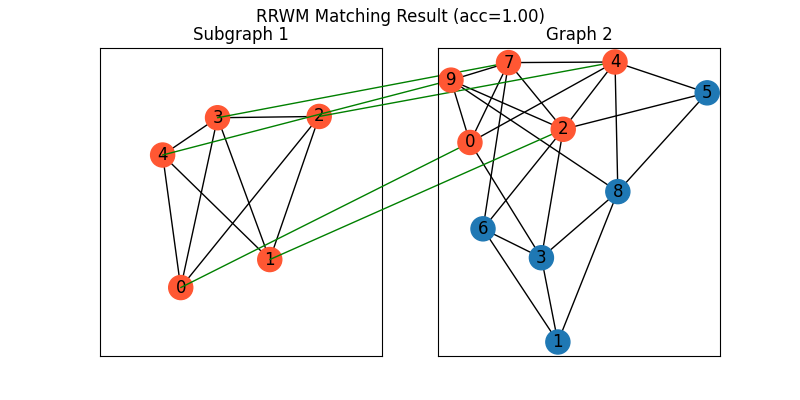
Other solvers are also available
Classic IPFP solver
See ipfp() for the API reference.
X = pygm.ipfp(K, n1, n2)
Visualization of IPFP matching result:
plt.figure(figsize=(8, 4))
plt.suptitle(f'IPFP Matching Result (acc={(X * X_gt).sum()/ X_gt.sum():.2f})')
ax1 = plt.subplot(1, 2, 1)
plt.title('Subgraph 1')
plt.gca().margins(0.4)
nx.draw_networkx(G1, pos=pos1, node_color=color1)
ax2 = plt.subplot(1, 2, 2)
plt.title('Graph 2')
nx.draw_networkx(G2, pos=pos2, node_color=color2)
for i in range(num_nodes1):
j = jt.argmax(X[i], dim=-1)[0].item()
con = ConnectionPatch(xyA=pos1[i], xyB=pos2[j], coordsA="data", coordsB="data",
axesA=ax1, axesB=ax2, color="green" if X_gt[i,j] == 1 else "red")
plt.gca().add_artist(con)
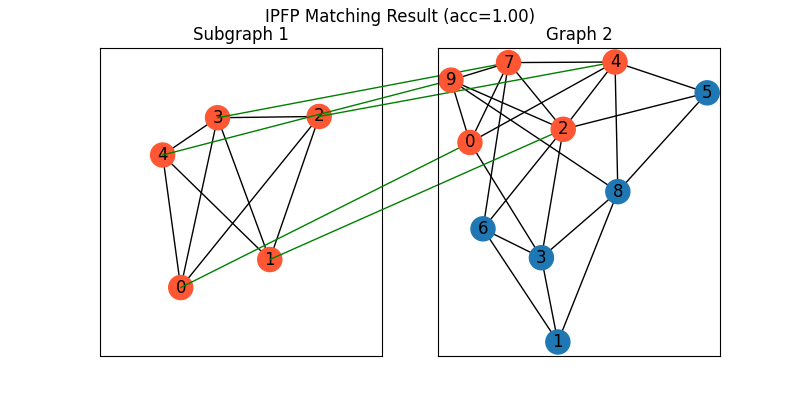
Classic SM solver
See sm() for the API reference.
X = pygm.sm(K, n1, n2)
X = pygm.hungarian(X)
Visualization of SM matching result:
plt.figure(figsize=(8, 4))
plt.suptitle(f'SM Matching Result (acc={(X * X_gt).sum()/ X_gt.sum():.2f})')
ax1 = plt.subplot(1, 2, 1)
plt.title('Subgraph 1')
plt.gca().margins(0.4)
nx.draw_networkx(G1, pos=pos1, node_color=color1)
ax2 = plt.subplot(1, 2, 2)
plt.title('Graph 2')
nx.draw_networkx(G2, pos=pos2, node_color=color2)
for i in range(num_nodes1):
j = jt.argmax(X[i], dim=-1)[0].item()
con = ConnectionPatch(xyA=pos1[i], xyB=pos2[j], coordsA="data", coordsB="data",
axesA=ax1, axesB=ax2, color="green" if X_gt[i,j] == 1 else "red")
plt.gca().add_artist(con)
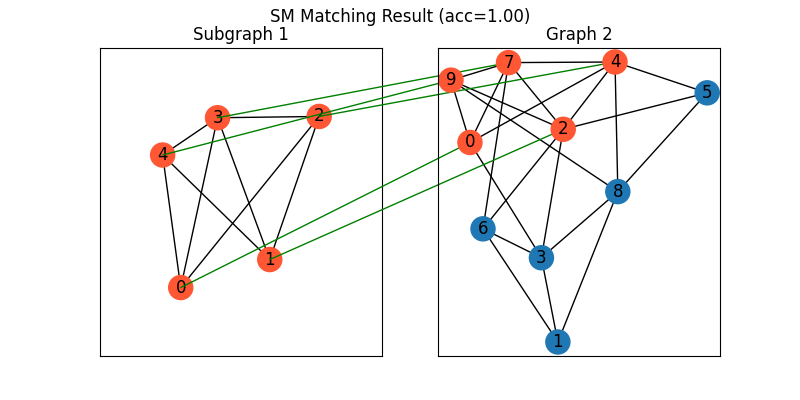
NGM neural network solver
See ngm() for the API reference.
Note
The NGM solvers are pretrained on a different problem setting, so their performance may seem inferior. To improve their performance, you may change the way of building affinity matrices, or try finetuning NGM on the new problem.
with jt.no_grad():
X = pygm.ngm(K, n1, n2, pretrain='voc')
X = pygm.hungarian(X)
Visualization of NGM matching result:
plt.figure(figsize=(8, 4))
plt.suptitle(f'NGM Matching Result (acc={(X * X_gt).sum()/ X_gt.sum():.2f})')
ax1 = plt.subplot(1, 2, 1)
plt.title('Subgraph 1')
plt.gca().margins(0.4)
nx.draw_networkx(G1, pos=pos1, node_color=color1)
ax2 = plt.subplot(1, 2, 2)
plt.title('Graph 2')
nx.draw_networkx(G2, pos=pos2, node_color=color2)
for i in range(num_nodes1):
j = jt.argmax(X[i], dim=-1)[0].item()
con = ConnectionPatch(xyA=pos1[i], xyB=pos2[j], coordsA="data", coordsB="data",
axesA=ax1, axesB=ax2, color="green" if X_gt[i,j] == 1 else "red")
plt.gca().add_artist(con)
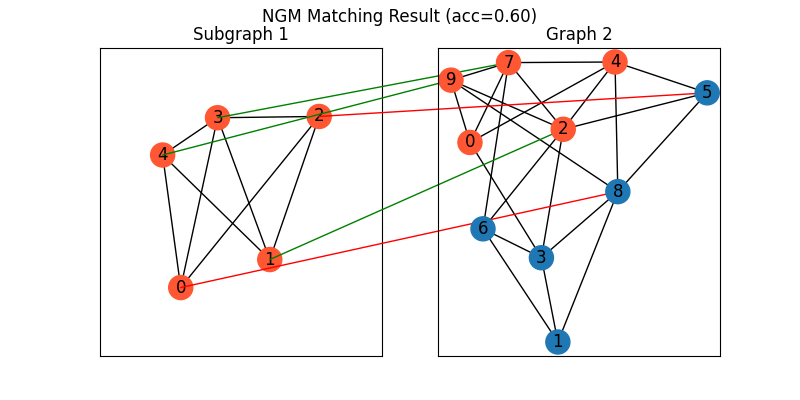
Total running time of the script: ( 0 minutes 1.073 seconds)